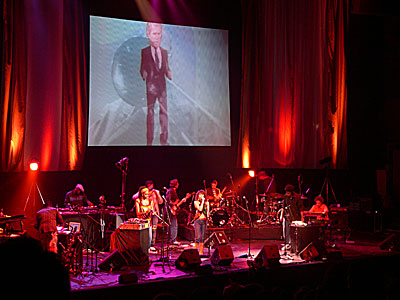
Vijay Iyer and Mike Ladd + Future Sounds Of Jazz
12 November 2004, Royal Festival Hall, London Jazz Festival
Vijay Iyer and Mike Ladd
Vijay Iyer and Mike Ladd might not be the main attraction for most of the audience on this, the opening night of the London Jazz Festival, but it’s to be hoped that one day they will be. Their only release to date, ‘In What Language?’, garnered widespread acclaim for its critical and poetic investigation into the worsening conditions experienced by people of colour in a post-9/11 world. As the two men take the stage dressed in charcoal grey suits Mike Ladd explains that their material is a work in progress about information refugees. The music comprises passages of thrumming beats and carefully composed ambiences that crossfade seamlessly into each other. Ladd and Iyer build their forms at the interstices of socially-conscious hiphop, beat poetry, tone painting and jazz. If that sounds like an overloaded palette, the duo make it sound effortless. Ladd’s delivery is generally wry, but also tinged with wonder as he mouths an imaginary talkshow interview with Laura Bush against a backdrop of plaintive strings. The result is a surreal elegy fuelled by an unexpected pathos. Towards the end of the set, Ladd refers scathingly to Billy Joel’s ‘We Didn’t Start The Fire’ before moving into the ominous atmospheres of ‘When This Anvil Lands’. If Ladd fulfils the role of seer, poet and committed observer then Iyer, member of NYC conduction ensemble Burnt Sugar and leader of piano trio Fieldwork, is a conjuror of soundworlds and composer of brilliant solos which, if there’s one regret, occur all too infrequently. Together and apart, these are two musicians to watch and tonight’s performance proves that their next project together will be well worth looking out for.
Future Sounds Of Jazz
The second set of the evening is a very different affair. Where Vijay Iyer
and Mike Ladd created a surprisingly intimate experience in the cavernous
Royal Festival Hall and painted pictures with sound, the 11 piece Future
Sounds Of Jazz employ visual unit Yeast to accompany them on two large screens
behind the stage at the same time as they attempt to whip up a party atmosphere.
Their failure to achieve this objective can’t be ascribed to any lack
of goodwill on the part of the band, but has much to do with Yeast’s
visuals which manage to preach, patronise and offend in equal measure. One
short sequence shows the silhouettes of New York’s twin towers animated
to create a Christian cross rapidly alternating with a flagellated Christ
and a smiling President Bush, while another conflates protests on a variety
of issues in Palestine, Brixton, southern America and India into an unfocused
generalisation that engenders a sense of hopelessness rather than righteous
ire. The ensemble are clearly politically conscious, but their message is
overloaded by the imagery rapidly changing above them. Despite this the
group’s music is a delight. Some of it unfolds out of small rhythmic
and melodic figures, there are solo spots (highlights include those by pianist
Matthew Bourne, keyboard player Nick Ramm and saxophonists Soweto Kinch
and Jason Yarde) and randomly picked trios which however prove a little
uneven. Future Sounds Of Jazz blend world and urban musics driven by everything
from blockparty beats to township rhythms into a cohesive whole that respects
rather than smothers its influences. Likewise the musicians accord each
other the space to explore themes. It’s just a pity that Yeast contradicted
such an inclusive vibe.

